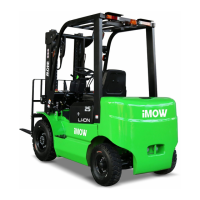What to do if EP Equipment Forklifts forks are lifted unevenly?
- AAmber GarciaSep 3, 2025
If your EP Equipment Forklifts forks are lifted unevenly, it could be due to lift chains out of adjustment. Adjust lift chains.

What to do if EP Equipment Forklifts forks are lifted unevenly?
If your EP Equipment Forklifts forks are lifted unevenly, it could be due to lift chains out of adjustment. Adjust lift chains.
Why are forks lifted or lowered unsmooth on EP Equipment IMOW ICE251 Forklifts?
If the forks on your EP Equipment Forklifts are lifted or lowered unsmoothly, it could be due to a carriage bracket assembly out of adjustment, insufficient clearance between inner and outer masts or rollers and the mast, biting foreign materials between moving parts, insufficient lubrication, or a bent carriage bracket assembly. Adjust clearance with thrust metal and carriage side roller, adjust clearance with rollers, remove foreign materials, apply grease on contact surfaces of sliding parts, or repair or replace the carriage bracket assembly.
Why do EP Equipment IMOW ICE251 Forklifts fork arms carrier move sluggishly?
If the fork arms carrier on your EP Equipment Forklifts moves up and down sluggishly, it could be caused by piston jamming, a bent piston rod, or too much dirt accumulated in the cylinder. Replace the faulty parts, strip it down and clean.
Why is the relief valve pressure unsteady on EP Equipment IMOW ICE251?
If the pressure of the relief valve in your EP Equipment Forklifts is not steady or is too low, it could be due to a loose pressure-adjust screw, a distorted or damaged pressure-adjust spring, a worn or blocked relief valve core, or pump abatement. Readjust and retighten the pressure-adjust screw, replace the spring, replace or clean the valve core, or examine and repair the pump.
What causes EP Equipment IMOW ICE251 Forklifts fork arm carrier to tilt by itself?
If your EP Equipment Forklifts' fork arm carrier or mast tilts by itself, it could be due to an excessively abraded tilt cylinder and ring, or an inoperative hydraulic control valve spring. Replace the piston ring tilt cylinder or replace the hydraulic control valve spring.
How to reduce excessive mast noise on EP Equipment IMOW ICE251?
If you notice excessive mast noise in your EP Equipment Forklifts, it could be caused by insufficient lubrication, improperly adjusted lift rollers, side rollers, and back-up metal, or a useless rubber pad on the lower outer mast for container forklift trucks. Lubricate the components, adjust the rollers and metal, or adjust shims and the rubber pad to ensure the piston rod touches the bottom of the cylinder body after the inner mast contacts the rubber pad.
What causes brake dragging in EP Equipment IMOW ICE251?
If your EP Equipment Forklifts exhibit brake dragging, it could be due to no free play of the brake pedal, improper shoe sliding, improper operation of the wheel cylinder, a faulty piston cup, weak or broken return springs, a clogged master cylinder return port, clogged oil lines, or wheel bearing out of adjustment. Try to adjust brake pedal, adjust shoe sliding, adjust or replace wheel cylinder, replace piston cup, replace return springs, clean master cylinder return port, clean oil lines or adjust or replace wheel bearing.
| Brand | EP Equipment |
|---|---|
| Model | IMOW ICE251 |
| Category | Forklifts |
| Language | English |
Important remarks regarding the manual's usage and content accuracy.
Crucial safety instructions to prevent serious injury to yourself and others.
Defines proprietor's duties for safe operation, maintenance, and adherence to manual.
Guidelines for mounting additional equipment and requirements for manufacturer approval.
Describes the intended use of the electric forklift truck for industrial floors and elevators.
Identifies and lists the various components and parts of the forklift truck.
Details the steering mechanism and the functions of the instrument display unit.
Explains important labels and data plates on the truck for identification and information.
Provides technical specifications for the standard version of the forklift truck.
Explains the critical relationship between load characteristics and truck stability.
Instructions for safely transporting the forklift truck by crane, securing, and towing.
Guidance for initial operation, including break-in procedures and battery connection.
Recommended operating conditions and procedures for the initial 100 hours of operation.
Essential safety rules and precautions for operating forklift trucks.
Step-by-step instructions for starting, operating, and controlling the forklift truck.
Details on how to travel, steer, and brake the forklift truck safely.
Procedures for picking up, stacking, and unstacking loads with the forklift.
Post-operation checks to ensure the truck is in good condition.
Safety precautions for handling and working with batteries.
Information on the battery model, voltage, capacity, and dimensions.
Procedures and precautions for charging the forklift's battery.
Step-by-step guide for safely removing and installing the battery.
Instructions for keeping the battery clean and in good working order.
Safety and environmental considerations for forklift truck maintenance.
Rules and guidelines for personnel performing maintenance.
Details on regular servicing, inspection tasks, and intervals.
Schedule and locations for lubricating various parts of the forklift.
Procedures for storing the truck for short or long periods.
Diagnosing and resolving issues related to the forklift's drive system.
Troubleshooting common problems with the steering system.
Identifying and correcting faults within the brake system.
Diagnosing issues with the hydraulic system, including pumps and valves.
Troubleshooting problems related to the lifting mechanisms and mast.
Identifying and resolving faults within the forklift's electrical system and fault codes.